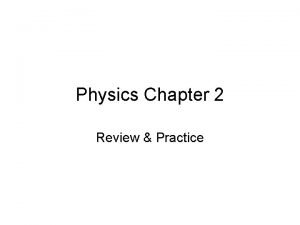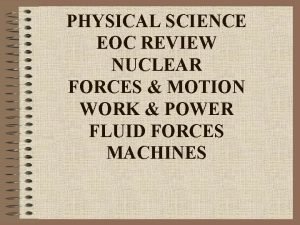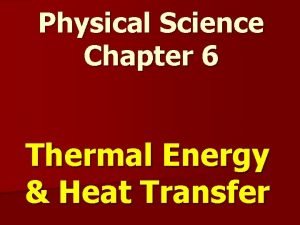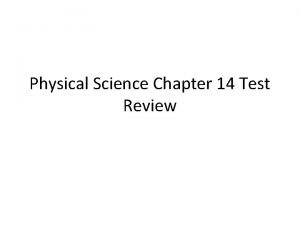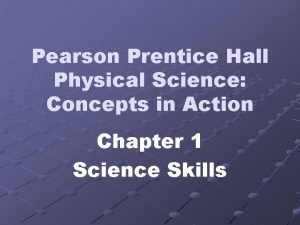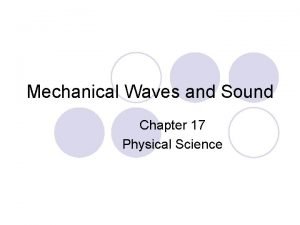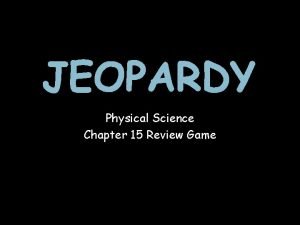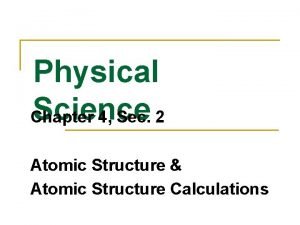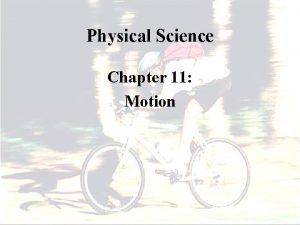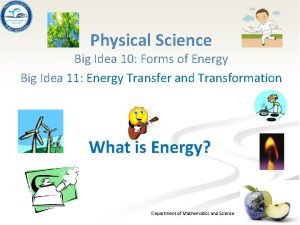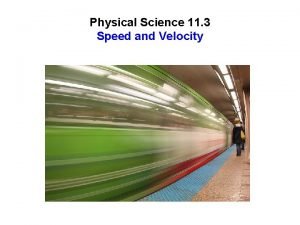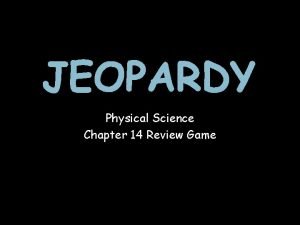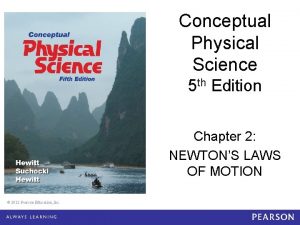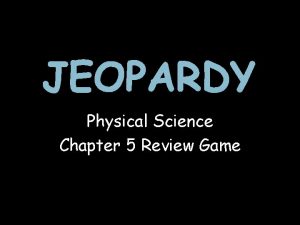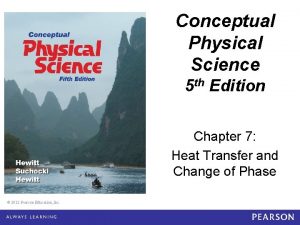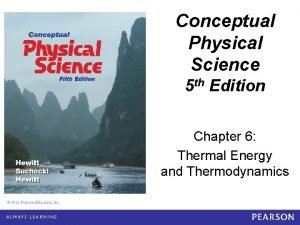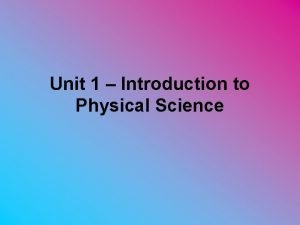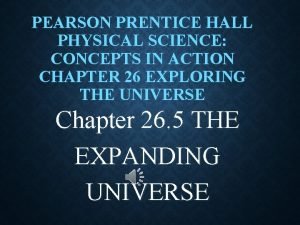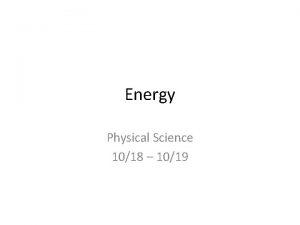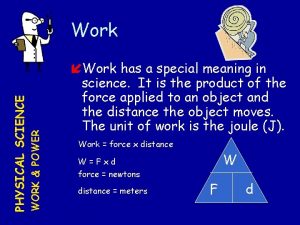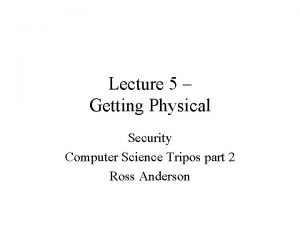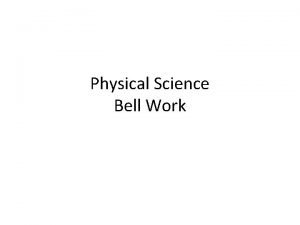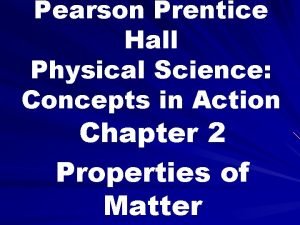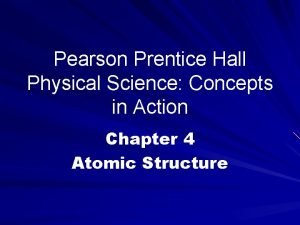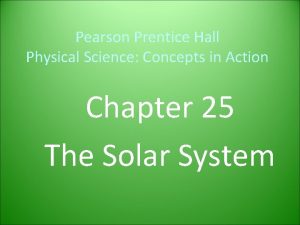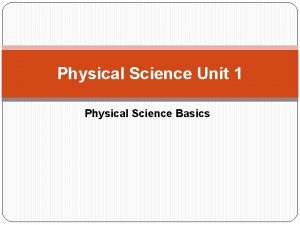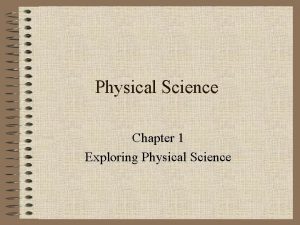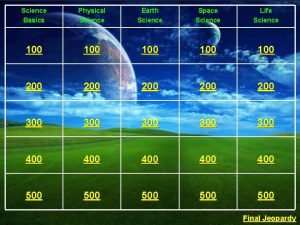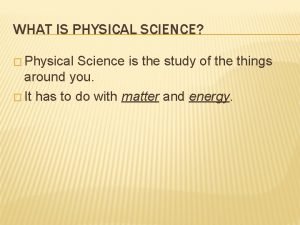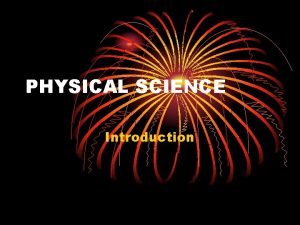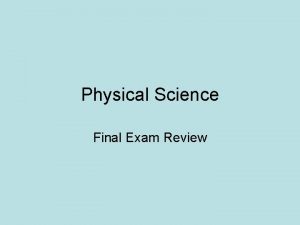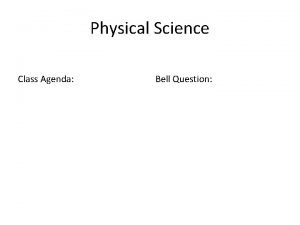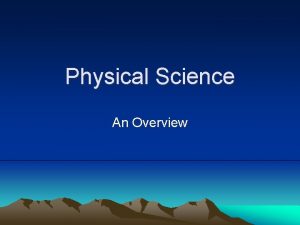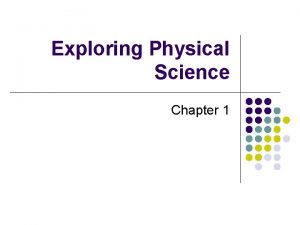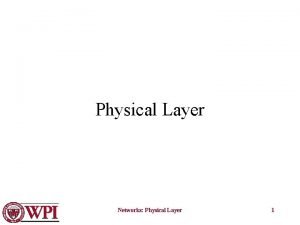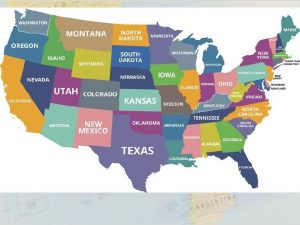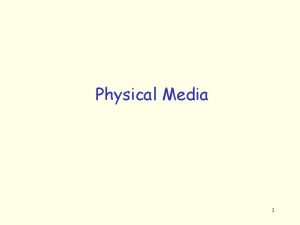ENERGY Physical Science What is Energy Energy is
















































- Slides: 48

ENERGY Physical Science

What is Energy? ? ? � Energy is all around us �How do you know that energy is here? �Can you feel energy? �Can you see energy? �Can you hear energy? � Energy is the capacity for doing work, which causes change � Energy can be in many different forms

Types of Energy THERMAL The ability to cause change. NUCLEAR SOUND joules (J) ENERGY MECHANICAL ELECTRICAL LIGHT CHEMICAL

Energy � Elastic Potential Energy – energy stored in springs Electrical Energy – energy from the flow of electrical charge � Light Energy – energy associated with electromagnetic radiation

� Nuclear Energy – energy released from a nuclear reaction (ie. fission and fusion) � Chemical Potential Energy – potential of a substance to undergo a transformation through a chemical reaction � Sound Energy – energy produced by vibrating matter

Energy � Kinetic Energy (KE) �Energy in the form of motion �Depends on mass and velocity �KE = ½ m v 2 �Units – Joules (J) • Which has the most KE? 80 km/h truck • Which has the least KE? 50 km/h motorcycle 80 km/h 50 km/h 80 km/h

Energy � Potential Energy (PE) �Stored energy �Depends on position of an object �PE = m g h = Fg h �Units – Joules (J) • Which boulder has greater gravitational PE?

Mechanical Energy � Energy associated with motion and position � Sum of the Kinetic Energy and Potential energy �ME = KE + PE

Thermal Energy � Measure of the total energy of the PARTICLES in a material ○ KE - movement of particles ○ PE - forces within or between particles due to position � Depends on temperature, mass, and type of substance � Measured in Calories or Joules ○ 1 calorie = 4. 18400 joules

Temperature � Measure of the average KE of the particles in a sample of matter � NOT THE SAME AS THERMAL ENERGY OR HEAT � Measured (SI Unit) in °C, °F, Kelvin

Thermal Energy � Which beaker of water has more thermal energy? �B same temp, more mass 80ºC A B 200 m. L 400 m. L

Conservation of Energy � Law of Conservation of Energy: Energy may change forms, but it cannot be created or destroyed!

Conservation of Mechanical Energy � Without friction: mechanical energy of a system is conserved �Initial ME = Final ME �Recall: ME= KE + PE � With friction: some mechanical energy is not lost, it is converted into heat �Initial ME = Final ME + heat �Total energy is conserved!

Conservation of a Roller Coaster

Conservation of a Skier

Conservation of a Pendulum

ENERGY TRANSFER u u Work/Devices Heat Transfer u Waves

Work � We had two definitions for work: � Force exerted through a distance � Transfer of energy through motion � When work is done, energy changes forms. � Ex: lifting a box, work converts your food (chemical potential) energy into gravitational potential energy � Ex: pushing on a wagon, work converts your food (chemical potential) energy into kinetic energy � Work is a transfer of energy

Let’s Think About This… Give an example of each transfer � Kinetic Electric generator � Chemical Potential Kinetic Gasoline engine � Gravitation Potential Kinetic Roller coaster � Chemical Potential Thermal Burning wood � Electrical Sound/Light bulb

Transfer of Thermal Energy � Heat �thermal energy that flows from a warmer material to a cooler material � Like work, heat is. . . �measured in joules (J) �a transfer of energy

Heat Transfer l Why does A feel hot and B feel cold? § Heat flows from A to your hand = hot. § Heat flows from your hand to B = cold. 80ºC A 10ºC B

Methods of Heat Transfer � Conduction – transfer of heat energy from one form of matter to another by direct contact. � Example: Electric stove. The hot coil is in contact with the pot and this contact makes it hot. � Convection – transfer of heat energy in fluids from rising and falling currents in a liquid or gas. � Example: Heater. The heater heats air around it, but the air currents transfer heat throughout the room. � Radiation – transfer of heat energy in the form of electromagnetic waves. � Example: Sunlight. It is an electromagnetic wave that travels through space without a medium and heats the earth surface.

Waves �Rhythmic disturbances that transfer energy through matter or space � Medium �Material used by wave to transport energy �Could be solid, liquid, gas, or combination �Electromagnetic waves don’t need a medium (e. g. visible light)

Types of Waves � Mechanical waves �Longitudinal waves �Transverse waves � Surface waves � Electromagnetic waves

Mechanical Waves that require a medium through which to travel. � Two types: � Longitudinal (a. k. a. compressional) – Medium moves in the same direction as wave motion. Ex: SOUND Transverse – medium moves perpendicular to the direction of wave motion

Surface Waves � Surface Waves: �Medium moves in a longitudinal and compressional motion Water Rayleigh surface waves Earthquake:

EM Radiation � Electromagnetic Waves (light) �Waves produced by the motion of electrically charged particles �Move through electric and magnetic fields, does not require a medium �All light travels at the same speed in a vacuum = 300, 000 m/s

Electromagnetic Spectrum Arranged by wavelength � Longer wavelength: lower frequency, lower energy � Shorter wavelength: higher frequency, higher enerygy �

Seeing Colors Stimulates red & green cones Different colors of light have different wavelengths � White light has all colors � The human eye retina contains… � �Rods - dim light, black & white �Cones - color ○ red - absorb red & yellow ○ green - absorb yellow & green ○ blue - absorb blue & violet Stimulates all cones

Seeing Colors � Color Blindness �one or more sets of cones do not function properly Test for red-green color blindness.


Negative Afterimage - One set of cones gets tired, and the remaining cones produce an image in the complimentary color.

Wave Parts � Wavelength (λ) – distance between one point on a wave and the nearest point just like it �Distance – measured in meters (m) Amplitude (A) – measure of the amount of energy in a wave � Period (T)– amount of time it takes one wavelength to pass a point � �Time – measured in seconds (s) � Frequency (f)– number of wavelengths that pass by a point each second �Equal to 1/period �Large period = small frequency � 1/time – measured in Hertz (Hz). 1 Hz = 1/s

Wave Parts � Transverse Wave �Equilibrium – rest position of particles � Longitudinal Wave �Compression – where particles are tightly spaced together �Rarefaction – where particles are spread apart

Measuring Waves � Velocity (v) �Speed of a wave as it moves forward �Depends on wave type and medium �Equation: v = λ f v: velocity(m/s) : wavelength (m) f: frequency (Hz)

Measuring Waves � EX: Find the velocity of a wave in a wave pool if its wavelength is 3. 2 m and its frequency is 0. 60 Hz. WORK: v= ×f GIVEN: v=? = 3. 2 m f = 0. 60 Hz v v = (3. 2 m)(0. 60 Hz) v = 1. 92 m/s f

Measuring Waves � EX: An earthquake produces a wave that has a wavelength of 417 m and travels at 5000 m/s. What is its frequency? WORK: f=v÷ GIVEN: = 417 m v = 5000 m/s f=? v f = (5000 m/s) ÷ (417 m) f = 12 Hz f

Wave Properties �Reflection �Refraction �Interference

Reflection � When a wave strikes an object and bounces off � Ex: Mirror � Ex: Sound echoing off a gym wall Light reflects at same angle from the normal � Normal – imaginary line perpendicular to the surface � Normal incident beam reflected beam

SONAR and RADAR � SONAR (sound navigation and ranging) – system that uses the reflection of sound waves to detect objects underwater � RADAR (radio detection and ranging) – system that uses the reflection of radio (form of EM) waves to find position and movement of objects

Refraction � Bending of waves when passing from one medium to another � Caused by a change in speed SLOWER �slower (more dense) light bends toward the normal �faster (less dense) light bends away from the normal FASTER

Refraction � Example:

Refraction � Example:

Refraction � Example �Amount of diffraction depends on wavelength of the light - shorter wavelengths (blue) bend more �Prism: white light enters, different colors bend a different amount

Refraction � Rainbows �White light from sun enters rain drop, it refracts, reflects, and refracts again.

Refraction � Double Rainbows �Light reflects twice inside rain drop

Interference � When two waves combine, they add � Two waves at the same point (in phase): highs add to be even higher � Waves at opposite points (out of phase): highs and lows can add to zero

Interference �constructive brighter light (highs add to be higher) �destructive dimmer light (highs and lows add to 0)
 3 branches of science
3 branches of science Natural and physical science
Natural and physical science My favorite subject is...
My favorite subject is... Physical rate fences
Physical rate fences Physical fitness test grade 9
Physical fitness test grade 9 Sains pada kurikulum paud
Sains pada kurikulum paud Physics chapter 2 review
Physics chapter 2 review Periodic table jeopardy
Periodic table jeopardy Physical science final exam study guide
Physical science final exam study guide Physical science eoc study guide
Physical science eoc study guide Physical science eoc review
Physical science eoc review Chapter 6 physical science
Chapter 6 physical science Chapter 4 work and energy section 1 work and machines
Chapter 4 work and energy section 1 work and machines Physical science chapter 14 review
Physical science chapter 14 review Which is a “big idea” of physical science?
Which is a “big idea” of physical science? Physical science lecture notes
Physical science lecture notes Prentice hall physical science concepts in action
Prentice hall physical science concepts in action Chapter 17 mechanical waves and sound
Chapter 17 mechanical waves and sound Physical science jeopardy
Physical science jeopardy Physical science force
Physical science force Pascc
Pascc What is displacement in physical science
What is displacement in physical science Chapter 4 review physical science
Chapter 4 review physical science Chapter 11 physical science
Chapter 11 physical science The big idea of energy
The big idea of energy Velocity physical science
Velocity physical science Chapter 14 review physical science
Chapter 14 review physical science Exploring physical science
Exploring physical science Conceptual physical science practice sheet chapter 2
Conceptual physical science practice sheet chapter 2 Wave notes
Wave notes Chapter 5 review physical science
Chapter 5 review physical science As your room gets messier day by day, entropy is
As your room gets messier day by day, entropy is When air rapidly expands its temperature normally
When air rapidly expands its temperature normally Heat is simply another word for
Heat is simply another word for Conceptual physical science 5th edition
Conceptual physical science 5th edition Lesson 1 thermal energy and the behavior of matter
Lesson 1 thermal energy and the behavior of matter K h d m d c m chart
K h d m d c m chart Examples of testimonial evidence
Examples of testimonial evidence Bacground
Bacground Physical science
Physical science Physical
Physical Physical science
Physical science Physical science 436
Physical science 436 Why johnny can't encrypt
Why johnny can't encrypt Physical science bell ringers
Physical science bell ringers Pearson physical science concepts in action
Pearson physical science concepts in action Pearson physical science concepts in action
Pearson physical science concepts in action Kuiper belt def
Kuiper belt def Chapter 16 review physical science
Chapter 16 review physical science






